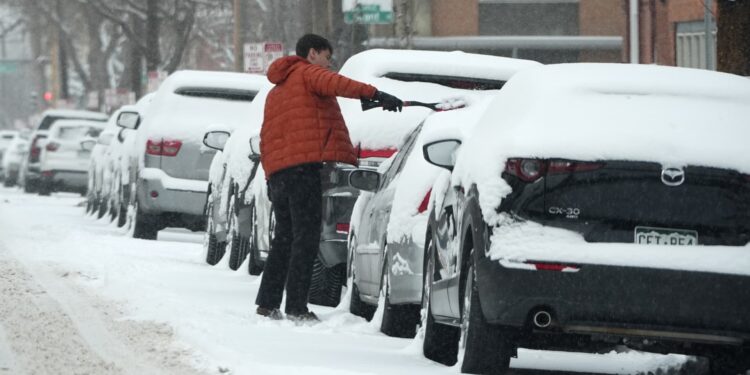A driver busily clears snow off his vehicle parked along First Avenue as a winter storm sweeps through the intermountain West, sending temperatures plunging into the single digits and leaving a light dusting of snow behind on Saturday, January 18, 2025, in Denver.
David Zalubowski | AP
Across the nation, over 175 million people are currently under some type of cold weather alert. The mid-Atlantic and Northeast regions are gearing up for another bout of rain and snow, meanwhile, the southern states are bracing themselves for unusually chilly temperatures and a rare sight of snowfall.
This cold snap comes immediately after another weather system that scattered rain and snow along parts of the East Coast on Saturday.
In the coming days, much of the country will experience varying levels of cold weather alerts due to what the National Weather Service describes as a “bitterly cold Arctic airmass” dropping temperatures anywhere from 10 to 40 degrees below what’s typical for this time of year.
Cold weather alerts are in place all the way from northern-tier states near the Canadian border down to the Gulf of Mexico. However, the northern Plains and the Rocky Mountains are expected to experience the harshest conditions, with wind chills dropping between minus 30 to minus 55 degrees.
‘Significant Snowfall’ Predicted for Houston
In Houston, temperatures plunged to freezing and below on Sunday night, as authorities dealt with a separate storm driven by low pressure. This storm was predicted to bring rain, turning to freezing rain, and eventually snow, from Monday into Tuesday, according to federal forecasters.
Due to these conditions, Houston’s George Bush Intercontinental Airport planned to shut down at midnight local time on Tuesday. Additionally, the Houston Independent School District and other public schools in the area decided to close on Tuesday in response to the impending weather.
The National Weather Service forecast discussion on Sunday mentioned, “snow totals would place this as one of the most substantial snowfall events in the history of the Greater Houston Area.”
David Zalubowski | AP
Mayor John Whitmire stated that city workers were applying deicing chemicals on the roads, but still urged drivers to stay off the roads during this severe weather event. “I’m convinced we’re about to face a very serious and dangerous weather situation,” he said during a Sunday press conference.
The storm was predicted to continue its path east along the Gulf Coast and southeastern U.S. on Tuesday, the National Weather Service added in a forecast discussion.
Alabama’s Mobile and Pensacola, Florida, could witness rare snowfall, with accumulations of 1 to 4 inches possible starting Tuesday.
Mid-Atlantic and Northeast Weather Outlook
Sunday afternoon witnessed scattered snow and rain gradually making their way across the Mid-Atlantic and Northeast regions.
Snowfall totals recorded on Sunday evening included 12 inches in Grantsville, Maryland, and 5.2 inches in Uniontown, Pennsylvania.
The snow was anticipated to draw to a close late Sunday or early Monday as the system moves into the Northeast, affecting states along the Interstate 95 corridor. Expected snowfall ranges from 2 to 6 inches. Meanwhile, light snow showers were projected to persist in New England early Monday, concluding before sunrise.
In Hartford, Connecticut, the weather service reported light snowfall on Sunday night, though only trace amounts had been recorded.
New York Governor Kathy Hochul instructed state agencies to prepare to respond to the storm, which could deliver between 4 to 6 inches of snow to New York City, 2 to 3 inches on Long Island, and up to 10 inches in the mid-Hudson region.
“New Yorkers are accustomed to winter weather, but I encourage everyone to ensure that you and your family are prepared for the snow and extreme cold, exercise caution when traveling, and stay up to date with your local forecast,” Governor Hochul stated.
Earlier on Sunday night, a few inches of snow fell in New York City, with Brooklyn’s Crown Heights neighborhood reporting 3 inches.
In other parts of New York, lake-effect snow was expected to develop downwind of Lake Ontario and Erie, with totals ranging from 2 to 6 inches through Sunday night, and possibly reaching up to 8 inches in some spots. Light snow was recorded in Buffalo and Albany late Sunday.
Philadelphia officials announced a “snow emergency” on Sunday night, prohibiting parking along major routes and other streets designated for first responder use during the storm.
New Jersey Governor Phil Murphy declared a state of emergency effective Sunday morning, urging residents to follow safety guidelines and avoid driving, as the state braces for potentially 8 to 12 inches of snow in certain regions.
In Boston, snow accumulation ranging from 4 to 8 inches was anticipated from Sunday afternoon into Monday morning.
Looking Ahead: The Week
As the week progresses, conditions in regions impacted by the Arctic blast are expected to gradually warm to near-average temperatures. However, highs will remain 5 to 15 degrees below what’s typical in the South through the upcoming weekend.
Some areas may still see record lows throughout the week, with places like Kansas City, Missouri; Baton Rouge, Louisiana; Pensacola, Florida; Detroit; Myrtle Beach, South Carolina; and Savannah, Georgia, potentially hitting new low-temperature records.
















